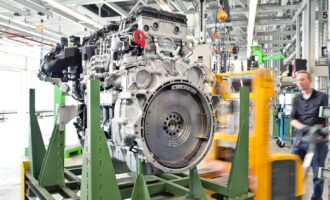Turbocharged Gasoline Direct Injection Engines’ (TGDI) little known secret
By Aaron Stone
China is experiencing astonishing growth in late model passenger car sales, with more than 24 million units sold in 2016. Turbocharged Gasoline Direct Injection (TGDI) engines are now being offered by all Chinese domestic OEMs as well as joint venture companies; though, Jerry Wang, Chevron Oronite’s technology manager for China, believes China doesn’t yet have the right oil technology to serve this flourishing market.
New TGDI powertrains are becoming widespread throughout the country. While no one has a true grasp on total volumes, Wang estimates that 50% of new vehicle sales in China could feature TGDI or GDI engines. For some OEMs, that proportion is significantly higher. Shanghai General Motors, for example, sold more than one million new vehicles during 2016-2017, all of which featured TGDI or GDI technology.
Wang also approximates 70% of the China car parc is less than five years old; a high volume of new sales ensuring the fleet is replenished very quickly with the latest technology, in stark contrast to the United States where he says turnover is much slower.
 Speaking at F+L Week 2017, Wang suggests that the Chinese market is going through an important transition period. Historically, he says, China has followed the rest of world, adopting specifications by OEMs in the U.S. and Europe, subsequently launching legacy products. The Oronite manager refers to the accelerating pace of change as the “coming of age of the China market.”
Speaking at F+L Week 2017, Wang suggests that the Chinese market is going through an important transition period. Historically, he says, China has followed the rest of world, adopting specifications by OEMs in the U.S. and Europe, subsequently launching legacy products. The Oronite manager refers to the accelerating pace of change as the “coming of age of the China market.”
China now has parity with global industry leaders on a range of critical issues, no longer lagging on emissions regulations (reaching Euro V/VI), fuel and fuel economy on par. New car powertrain technology (including TGDI) is also in sync with the latest global trends, that require the newest lubricant categories.
However, Wang, who has a doctorate in Chemical Engineering from Penn State University in the United States, warns TGDI engines have a “little known secret,” that could have strong ramifications for the China region; the presence of particulates in vehicle exhaust emissions, similar to a diesel engine.
With the continued influx of new vehicles, this has the potential to place increasing stress on air quality in major cities in China. A 2014 study by Beijing’s environmental protection bureau suggests that vehicle emissions account for more than 30% of concentrations of small breathable particles. The Chinese government is taking action via stricter regulation; millions of TGDI engines in China may require gasoline particulate filters (GPF).
“Based on China GB regulations, particulate numbers are required in the specifications,” says Wang
This means that “it may require a gasoline particulate filter therefore a compatible engine oil such as reduced ash.” He believes this poses a significant risk with the implementation of GPF “about a year from now,” and a lack of research available on the topic.
Despite the assertion that China has the “largest market of TGDI and GDI engines in the world,” Wang attests “we don’t have an adequate oil for them.” With the absence of an appropriate higher specification “mid-ash TGDI passenger car oil, mid GF-5,” China is not well prepared for a change in standards, he believes.
GF-6 will address some known TGDI specific issues, such as LSPI prevention and a wide base oil and viscosity grade coverage but not necessarily GPF. Unfortunately, GF-6 delays are well documented, with first licensing “maybe” in 2019. At present, the next major engine oil category is proceeding without a confirmed launch date.
 A high number of TGDI engines on the road means China needs a higher specification than the current GF-5. Wang believes the market is “crying out” for a mid-grade product between GF-5 and GF-6. While General Motors’ dexos1™:2015 does address TGDI requirements specifically, and provides one potential solution, this certification is specific to GM, and is not suitable for all OEMs.
A high number of TGDI engines on the road means China needs a higher specification than the current GF-5. Wang believes the market is “crying out” for a mid-grade product between GF-5 and GF-6. While General Motors’ dexos1™:2015 does address TGDI requirements specifically, and provides one potential solution, this certification is specific to GM, and is not suitable for all OEMs.
The China National Standard for engine oils is GB. This specification is mostly consistent with the American Petroleum Institute (API), with some additional requirements, although the test methods are not identical to ASTM, there is no formal recognition of the American Chemistry Council (ACC) Code of Practice, and there are no ASTM-monitored labs.
Change is indeed afoot in the China market. The recent formation of a China Engine Oil Union is first evidence that China will not necessarily continue to follow the United States and Europe. The alliance is developing a ground-breaking domestic heavy-duty diesel engine oil specification, planned for national release in 2019.
To address TGDI’s “little known secret” we need to act now, says Wang. Waiting for GF-6 is simply not an option with tens of millions of TGDI engines already on the road. He says product development needs to design for GB or future China specifications.
The Oronite representative lent his voice to an increasing chorus to change the approach to industry specifications, asking for a “new and open process” to create meaningful requirements, and confirming the need for a timelier response. “The days of spending five years developing a new specification, and a further five on product development” are gone, he says. The lifecycle of our products is becoming increasingly short, declares Wang.







